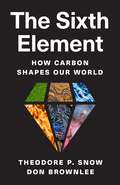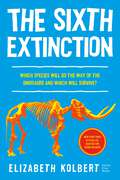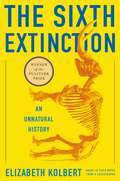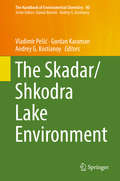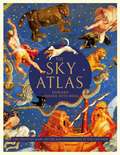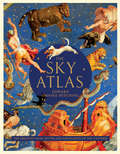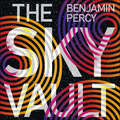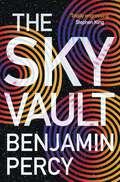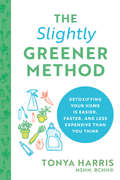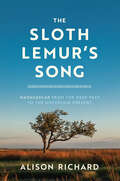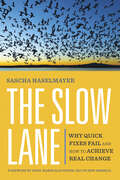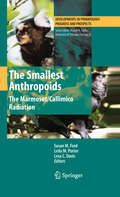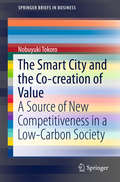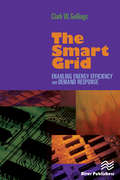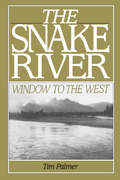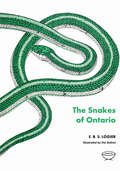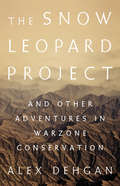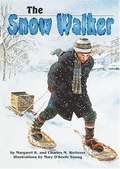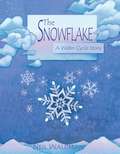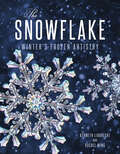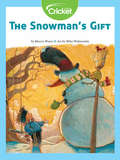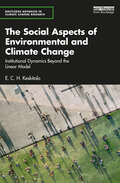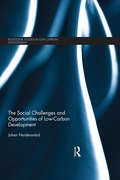- Table View
- List View
The Sixth Element: How Carbon Shapes Our World
by Theodore P. Snow Don BrownleeA cosmic perspective on carbon—its importance in the universe and our livesWhen we think of carbon, we might first think of a simple element near the top of the periodic table: symbol C, atomic number 6. Alternatively, we might think of something more tangible—a sooty piece of coal or a sparkling diamond, both made of carbon. Or, as Earth&’s temperature continues to rise alarmingly, we might think of the role carbon plays in climate change. Yet carbon&’s story begins long ago, far from earthly concerns. In The Sixth Element, astronomers Theodore Snow and Don Brownlee tell the story of carbon from a cosmic perspective—how it was born in the fiery furnaces of stars, what special chemical and physical properties it has, and how it forms the chemical backbone of the planets and all life as we know it. Foundational to every part of our lives, from our bodies to the food, tools, and atmosphere that sustain our existence, carbon is arguably humankind&’s most important element.Snow and Brownlee offer readers the ideal introduction to the starry element that made our world possible and shapes our lives. They first discuss carbon&’s origin, discovery, and unique ability to bond with other elements and form countless molecules. Next, they reveal carbon&’s essential role in the chemical evolution of the universe and the formation and evolution of galaxies, stars, planets, and life, and then, more generally, its technological uses and its influence on Earth&’s climate. Bringing readers on a historical, scientific, and cross-disciplinary journey, The Sixth Element illuminates the cosmic wonder that is carbon.
The Sixth Extinction (young readers adaptation): An Unnatural History
by Elizabeth KolbertIn this young readers adaptation of the New York Times-bestselling, Pulitzer Prize-winning The Sixth Extinction, Elizabeth Kolbert tells us why and how human beings have altered life on the planet in a way no species has before. Over the last half-billion years, there have been five mass extinctions, when the diversity of life on earth suddenly and dramatically contracted. Scientists around the world are monitoring the sixth extinction, predicted to be the most devastating extinction event since the asteroid impact that wiped out the dinosaurs. Adapting from her New York Times-bestselling, Pulitzer Prize-winning adult nonfiction, Elizabeth Kolbert explores how humans are altering life on Earth.
The Sixth Extinction: An Unnatural History
by Elizabeth KolbertA major book about the future of the world, blending intellectual and natural history and field reporting into a powerful account of the mass extinction unfolding before our eyes.<p><p> Over the last half a billion years, there have been five mass extinctions, when the diversity of life on earth suddenly and dramatically contracted. Scientists around the world are currently monitoring the sixth extinction, predicted to be the most devastating extinction event since the asteroid impact that wiped out the dinosaurs. This time around, the cataclysm is us. <p> In The Sixth Extinction, two-time winner of the National Magazine Award and New Yorker writer Elizabeth Kolbert draws on the work of scores of researchers in half a dozen disciplines, accompanying many of them into the field: geologists who study deep ocean cores, botanists who follow the tree line as it climbs up the Andes, marine biologists who dive off the Great Barrier Reef. She introduces us to a dozen species, some already gone, others facing extinction, including the Panamian golden frog, staghorn coral, the great auk, and the Sumatran rhino. <p> Through these stories, Kolbert provides a moving account of the disappearances occurring all around us and traces the evolution of extinction as concept, from its first articulation by Georges Cuvier in revolutionary Paris up through the present day. The sixth extinction is likely to be mankind's most lasting legacy; as Kolbert observes, it compels us to rethink the fundamental question of what it means to be human. <p> Pulitzer Prize Winner
The Skadar/Shkodra Lake Environment (The Handbook of Environmental Chemistry #80)
by Andrey G. Kostianoy Vladimir Pešić Gordan KaramanThis book reviews the unique ecosystem of the Lake Skadar/Shkodra and its basin, and discusses the latest advances made in this region to face the impact of climate change. Divided into 23 chapters, the book gathers leading expertise from various scientific and engineering communities and provides readers with extensive discussions of core issues, including the water and sediment chemistry of Lake Skadar/Shkodra and the metal pollution that is evident in plants, aquatic invertebrates and fish. Readers will discover how a sustainable science-based management approach can be applied to the Lake Skadar/Shkodra region, and will learn about the environment prospects for the region. This book is intended as an essential tool for all scientists interested in the Lake Skadar/Shkodra environment – in particular those investigating the interactions between land and water, between limnology and biota, and between natural and cultural resources.
The Skeptical Environmentalist: Measuring the Real State of the World
by Bjørn LomborgThe Skeptical Environmentalist challenges widely held beliefs that the environmental situation is getting worse and worse and is critical of the way in which many environmental organizations make selective and misleading use of the scientific evidence. Using the best available statistical information from internationally recognized research institutes, it systematically examines a range of major environmental problems that feature prominently in headline news across the world.
The Sky Atlas: The Greatest Maps, Myths and Discoveries of the Universe
by Edward Brooke-HitchingAfter the enormous international success of The Phantom Atlas and The Golden Atlas, Edward Brooke-Hitching's stunning new book unveils some of the most beautiful maps and charts ever created during mankind's quest to map the skies above us. This richly illustrated treasury showcases the finest examples of celestial cartography - a glorious genre of map-making often overlooked by modern map books - as well as medieval manuscripts, masterpiece paintings, ancient star catalogues, antique instruments and other appealing curiosities. This is the sky as it has never been presented before: the realm of stars and planets, but also of gods, devils, weather wizards, flying sailors, medieval aliens, mythological animals and rampaging spirits. The reader is taken on a tour of star-obsessed cultures around the world, learning about Tibetan sky burials, star-covered Inuit dancing coats, Mongolian astral prophets and Sir William Herschel's 1781 discovery of Uranus, the first planet to be found since antiquity. Even stranger are the forgotten stories from European history, like the English belief of the Middle Ages in ships that sailed a sea above the clouds, 16th-century German UFO sightings and the Edwardian aristocrat who mistakenly mapped alien-made canals on the surface of Mars.As the intricacies of our universe are today being revealed with unprecedented clarity, there has never been a better time for a highly readable book as beautiful as the night sky to contextualise the scale of these achievements for the general reader.
The Sky Atlas: The Greatest Maps, Myths, and Discoveries of the Universe
by Edward Brooke-HitchingThe Sky Atlas unveils some of the most beautiful maps and charts ever created during humankind's quest to map the skies above us. This richly illustrated treasury showcases the finest examples of celestial cartography—a glorious art often overlooked by modern map books—as well as medieval manuscripts, masterpiece paintings, ancient star catalogs, antique instruments, and other curiosities. This is the sky as it has never been presented before: the realm of stars and planets, but also of gods, devils, weather wizards, flying sailors, ancient aliens, mythological animals, and rampaging spirits. • Packed with celestial maps, illustrations, and stories of places, people, and creatures that different cultures throughout history have observed or imagined in the heavens• Readers are taken on a tour of star-obsessed cultures around the world, learning about Tibetan sky burials, star-covered Inuit dancing coats, Mongolian astral prophets and Sir William Herschel's 1781 discovery of Uranus, the first planet to be found since antiquity.• A gorgeous book that delights stargazers and map lovers alikeWith thrilling stories and gorgeous artwork, this remarkable atlas explores our fascination with the sky across time and cultures to form an extraordinary chronicle of cosmic imagination and discovery.The Sky Atlas is a wonderful book for map lovers, history buffs, and stargazers, but also for those who are intrigued by the many wonderful and bizarre ways in which humans have sought to understand the cosmos and our place in it.• A unique map book that expands beyond the terrestrial and into the celestial• A wonderful book for map lovers, obscure-history fans, mythology buffs, and astrology and astronomy lovers• Great for those who enjoyed What We See in the Stars: An Illustrated Tour of the Night Sky by Kelsey Oseid, Maps by Aleksandra Mizielinska and Daniel Mizielinski, and Atlas of Remote Islands: Fifty Islands I Have Never Set Foot On and Never Will by Judith Schalansky
The Sky Vault: The Comet Cycle Book 3 (The Comet Cycle #2)
by Benjamin PercyThe third and final book in Percy's innovative and acclaimed Comet Cycle, The Sky Vault follows the aftermath of an airplane that goes missing over Fairbanks, Alaska, in the wake of the comet, and a teenager's search for answers about his father's final moments aboard the flight.The comet, Cain, came from beyond our solar system, its debris containing elements unknown. It brought a powerful new metal to the once-declining Midwest; alien fungus to the forests of the Pacific Northwest; and now, in the isolated region of Fairbanks, Alaska, the skies shift and stretch as an interstellar dust cloud seeds itself in the atmosphere. The National Weather Service dismisses the anomaly. Then, an hour outside of Fairbanks, a plane shudders its way through pulpy, swirling, bruise-shaped clouds, lit with sudden cracks of lightning. The sky opens. And the plane vanishes.Theo Jenson is fifteen years old when his father inexplicably disappears along with the plane, and the month-long search for him ends with a funeral procession and the beginnings of acceptance. Despite the tragedy, Theo's popularity in school skyrockets, while his best friend Wheezy remains on the outskirts of any real social circle. Their friendship will be put to the test when other Fairbanks citizens begin to vanish, sucked up by a funnel cloud that extends like an elephant's trunk, and chased down by a mist that solidifies into the shape of a man.Most comets, it's generally believed, are made of a combination of rock and ice. But the fact that so many of them blink out of existence - seen one day, gone the next - makes some scientists believe they are cored with something known as "mirror matter," another term for the dark matter we know exists in the universe because of its gravitational force. The effects of Cain's dark matter are still not entirely known, but its impact on Earth might be more treacherous, or sublime, than could ever be imagined.(P) 2023 HarperCollins Publishers
The Sky Vault: The Comet Cycle Book 3 (The Comet Cycle #2)
by Benjamin Percy'Totally engrossing' - STEPHEN KING on The Ninth MetalTHE FINAL BOOK IN PERCY'S CRITICALLY CLAIMED COMET CYCLE SERIES!The comet, Cain, came from beyond our solar system, its debris containing elements unknown. Now, in the isolated region of Fairbanks, Alaska, the skies shift and stretch as an interstellar dust cloud seeds the atmosphere. When a plane shudders its way through pulpy, swirling, bruise-shaped clouds, lit with sudden cracks of lightning, the sky opens and the aircraft vanishes...but only for a minute.When the flight lands, everyone on board and in the community will be changed forever. Chuck Bridges, a local DJ and conspiracy theorist, was on board and later reported dead to his family, but not before proclaiming that something inside the clouds was speaking to him. Now his son, Theo, must chase down answers to the mystery his father unlocked. He'll find himself at odds with Sophie Chen, an agent with a shadowy employer desperate to secure the black box from the airplane, as well as Rolf Wagner, a widowed sheriff investigating a series of increasingly strange and unsettling reports. And then there is Joanna Straub, a contractor reconstructing a top-secret government lab active during WWII and shuttered deep within the nearby White Mountains.The answer to the comet's origin is about to be unveiled, and its impact on Earth is more treacherous and sublime than humanity could imagine.'Take one part dystopia, one part sci-fi, two parts apocalypse, then ride them roughshod through a bleak and bloody western, and it still wouldn't get close to what Ben Percy does here, which is blow open the core of humanity's dark heart.' - Marlon James, Booker Prize-winning author of Black Leopard, Red Wolf, on The Ninth Metal 'The Stephen King of science fiction.' - Margaret Stohl, New York Times bestselling author, on The Ninth Metal'Audacious and intelligent and exactly what I was dying to read.' - Victor LaValle, author of The Changeling, on The Ninth Metal'This standout combination of science and psychology is sure to wow SF fans.' Publishers Weekly (starred review)
The Slightly Greener Method: Detoxifying Your Home Is Easier, Faster, and Less Expensive than You Think
by Tonya HarrisFrom the foods you consume to the household and personal care products you buy, being just slightly greener can have a big impact on your health and happiness!The Slightly Greener Method gives you small, actionable changes you can easily make in three areas of your home—the kitchen (foods and beverages), bathroom (personal care products and cosmetics), and cleaning products—without breaking the bank or upending your life.You don't have to be 100% chemical free to be healthier and safer. By focusing on micro-habits you can build over time and the gradual introduction of non-toxic, all-natural or organic, eco-friendly products, board-certified holistic nutritionist Tonya Harris guides you along a roadmap to a greener, more environmentally-friendly and sustainable lifestyle that can help protect you and your families' health long-term.Get answers to questions like:What does "organic" really mean?Which of the unpronounceable chemicals listed on the back of my shampoo bottle might be toxic?Do I really need to throw away expired makeup?Why aren't companies always required to list toxic ingredients on their product labels?How can I make sure my kids and pets are safe while also keeping a squeaky clean house?It's never too soon (or too late) to start your slightly greener journey! This practical, actionable guide is perfect for readers of bestselling lifestyle and organizational books such as The Complete Book of Clean and Zero Waste Home, and fans of TV shows like Tidying Up with Marie Kondo and The Home Edit.
The Sloth Lemur's Song: Madagascar from the Deep Past to the Uncertain Present
by Alison RichardA moving account of Madagascar told by a researcher who has spent over fifty years investigating the mysteries of this remarkable island. Madagascar is a place of change. A biodiversity hotspot and the fourth largest island on the planet, it has been home to a spectacular parade of animals, from giant flightless birds and giant tortoises on the ground to agile lemurs leaping through the treetops. Some species live on; many have vanished in the distant or recent past. Over vast stretches of time, Madagascar’s forests have expanded and contracted in response to shifting climates, and the hand of people is clear in changes during the last thousand years or so. Today, Madagascar is a microcosm of global trends. What happens there in the decades ahead can, perhaps, suggest ways to help turn the tide on the environmental crisis now sweeping the world. The Sloth Lemur’s Song is a far-reaching account of Madagascar’s past and present, led by an expert guide who has immersed herself in research and conservation activities with village communities on the island for nearly fifty years. Alison Richard accompanies the reader on a journey through space and time—from Madagascar’s ancient origins as a landlocked region of Gondwana and its emergence as an island to the modern-day developments that make the survival of its array of plants and animals increasingly uncertain. Weaving together scientific evidence with Richard’s own experiences and exploring the power of stories to shape our understanding of events, this book captures the magic as well as the tensions that swirl around this island nation.
The Slow Lane: Why Quick Fixes Fail and How to Achieve Real Change
by Sascha HaselmayerAvoid the speed trap! Discover how changemakers can find lasting solutions to urgent social problems through a proven 5-step process for listening thoughtfully, building broad support, and exploring unconventional options. Society celebrates leaders who promise fast, easy solutions to the world's problems—but quick fixes are just mirages that fade, leaving us with the same broken systems. The truth is, effective social change happens through slow, intentional actions. The author, a globally acclaimed social entrepreneur, offers a 5-step process for taking the slow lane to change-the lane that gets you to the right place faster: Listening—Listen to build trust, which can change hearts and minds and allow for something new to emerge. Holding the urgency—Accept that even in moments of crisis you can move only at the speed of trust instead of rushing into action. Sharing the agency—Create an inclusive environment where everyone can lead.Healing democracy—Build bridges that allow marginalized people to participate.Maintaining curiosity—Be inspired by nontraditional sources.Using dozens of examples—prison reform in England, urban development in Venezuela, healthcare in the Navajo Nation, early childhood education in New York, and many more—The Slow Lane shows how, by following the principles taught in this book, readers can create lasting change.
The Smallest Anthropoids
by Leila M. Porter Susan M. Ford Lesa C. DavisThis volume represents a comprehensive examination of the newly recognized callimico/marmoset clade, which includes the smallest anthropoid primates on earth. It will explore these diminutive primates in their entirety, with sections on phylogeny, taxonomy and functional anatomy, behavioral ecology, reproductive physiology, as well as address critical conservation issues and the need for conservation action. The topics specifically selected for this volume are pivotal for understanding the evolutionary adaptations and divergence of any primate group, and especially one as diverse and curious as this. The discoveries of new taxa over the last fifteen years along with new genetic data have transformed this group from three genera (one with only a distant relationship to the others) and five recognized species, to five closely related genera, comprising at least 22 species. This volume will be the first to synthesize data on these newly recognized taxa. This volume is an international endeavor, bringing together primary callimico and marmoset researchers from around the globe, including Brazil and the United States as well as Greece, Italy, Switzerland, and Germany. One of the merits of this volume is that it will serve as a readily accessible work that includes the major findings of several key international researchers whose work has not been easily available to English-speaking scholars. In addition, it draws together lab and field researchers, geneticists, anatomists, and behaviorists in an integrated volume that will provide the most detailed and thorough work on either callimicos or marmosets to date. This volume will also provide a timely forum for identifying future avenues of action necessary for more fully understanding and protecting this intriguing primate radiation.
The Smart City and the Co-creation of Value
by Nobuyuki TokoroThe original point that differentiates this text from otherwise similar texts is that it looks at the building of smart cities from the viewpoint of an interchange of knowledge among companies in different industries, or "Ba" as shared context in motion, and emphasizes that the resulting value becomes a source of new corporate competitive advantage. In recent years numerous publications have appeared that analyze smart cities from various perspectives including urban planning and administration, network theory, and innovation. However, few are academic texts that approach the subject from the viewpoint of corporate competitive advantage against a theoretical background in management studies, as this one does. This book is the first full-scale academic work to analyze smart cities from the viewpoint of corporate competitive advantage. Research into corporate competitive advantage includes the positioning and the resource-based views, with the former focusing on companies' external environment and the latter on their internal resources. Although these theories' foci of attention necessarily differ, they both developed as tools for analyzing companies' relative merits and their chances of succeeding in the marketplace, and they take the common premise that competitive advantage is built through competition among companies. In contrast, this book sees corporate competitive advantage as arising not through competition but through "co-creation" among companies. It differs in its approach from existing theories in thinking that emphasizing co-creation over competition enables an analysis that better describes actual conditions when considering smart cities and corporate competitive advantage. Put another way, when new values arise from attempts to exchange and fuse knowledge, expertise, and other factors at the "ba" where companies from different industries collaborate, these values are surely brought about through co-creation among companies. Another point regarding this book's original perspective on competitive advantage is its emphasis on the relationship between the creation of social value and competitive advantage. The question of the extent to which socially useful values can be created in the markets of the 21st century is closely linked to corporate competitive advantage. The issues of building smart cities and corporate competitive advantage are themes that this perspective can firmly grasp. This book intends to take up three different projects from among the smart-city building developments taking shape in Japan, and undertake case studies based on the theoretical framework outlined above. The central themes will analyze the mechanism of co-creation among companies and the relationship of created value to competitive advantage. This analysis aims to demonstrate one model relating to corporate competitive advantage in the 21st century.
The Smart Grid: Enabling Energy Efficiency and Demand Response
by Clark W. GellingsThe power system has often been cited as the greatest and most complex machine ever built, yet it is predominantly a mechanical system. Technologies and intelligent systems are now available that can significantly enhance the overall functionality of power distribution and make it ready to meet the needs of the 21st century. This book explains how sensors, communications technologies, computational ability, control, and feedback mechanisms can be effectively combined to create this new, continually adjusting "smart grid" system. It provides an understanding of both IntelliGridSM architecture and EnergyPortSM as well as how to integrate intelligent systems to achieve the goals of reliability, cost containment, energy efficiency in power production and delivery, and end-use energy efficiency.
The Snake River: Window To The West
by Tim PalmerTim Palmer weaves natural history into a comprehensive account of the complex problems that plague natural resource management throughout the West, as well as the practical solutions that are available.
The Snakes of Ontario
by E.B.S. LogierMany people have a great fear of snakes. This fear affects their peace of mind, their enjoyment of a holiday in the country, and even their pleasure in their own suburban gardens. It leads to the senseless destruction of one of our valuable natural resources. The morbid fear of snakes can only be dispelled by learning the true facts about these fascinating creatures. This book is addressed to anyone who wishes to learn about the natural history of snakes, or to identify those found in Ontario, but the author speaks particularly to young people, who, unless they have been prejudiced, have a natural interest in all living things. In an easy, conversational manner, the author gives a general account of snakes--what they are, how they travel, their instinct and intelligence, how they feed, their reproduction, hiberation, shedding of the skin, defences usefulness--and discusses popular beliefs and fear of snakes. The separate species are fully described in a simple, non-technical and readable style. The author is also an artist, and the book is illustrated with his own wash drawings and line sketches. There are two beautiful colour plates. Distribution maps show the range of species. For those wishing to pursue the study of snakes more fully, an appendix provides a list of snakes with scientific names, a key for the identification of the snakes, directions for determining their sex, directions for collection and preserving, directions for determining their sex, directions for keeping snakes as pets, diagrams giving anatomical names of parts of snakes, a glossary, and a concise and up-to-date outline of rattlesnake bite and first aid treatment.
The Snow Booklet: A Guide to the Science, Climatology, and Measurement of Snow in the United States (2nd edition)
by Nolan J. Doesken Arthur JudsonWritten for climatological observers and their managers, snow-fighters, urban planners, winter recreationists, and all who find in snow a sense of inspiration and awe, this profusely illustrated book provides a wealth of snow data. Contents: the power and beauty of snow; the science of snow; climatology of snow in the U. S. ; measuring snow; problems and challenges in measuring snow; procedure for measuring snow; dealing with adversity (blizzards); common questions about snow; and more. Illustrated with comparative charts and graphs, diagrams, and black and white and color photos. Bibliography. Glossary of snow terms.
The Snow Leopard Project: And Other Adventures in Warzone Conservation
by Alex DehganThe remarkable story of the heroic effort to save and preserve Afghanistan's wildlife-and a culture that derives immense pride and a sense of national identity from its natural landscape.Postwar Afghanistan is fragile, volatile, and perilous. It is also a place of extraordinary beauty. Evolutionary biologist Alex Dehgan arrived in the country in 2006 to build the Wildlife Conservation Society's Afghanistan Program, and preserve and protect Afghanistan's unique and extraordinary environment, which had been decimated after decades of war.Conservation, it turned out, provided a common bond between Alex's team and the people of Afghanistan. His international team worked unarmed in some of the most dangerous places in the country-places so remote that winding roads would abruptly disappear, and travel was on foot, yak, or mule. In The Snow Leopard Project, Dehgan takes readers along with him on his adventure as his team helps create the country's first national park, completes the some of the first extensive wildlife surveys in thirty years, and works to stop the poaching of the country's iconic endangered animals, including the elusive snow leopard. In doing so, they help restore a part of Afghan identity that is ineffably tied to the land itself.
The Snow Walker
by Charles M. Wetterer Margaret K. WettererDuring the blizzard of 1888, a young boy travels through the snow to bring needed groceries to his neighbors.
The Snowflake: A Water Cycle Story
by Neil WaldmanFollows the journey of a water droplet through the various stages of the water cycle, from precipitation to evaporation and condensation.
The Snowflake: Winter's Frozen Artistry
by Kenneth Libbrecht Rachel WingA chronicle of snow crystal creation from the Caltech physicist known as the world’s leading snowflake expert and consultant for the movie Frozen.Snowflakes may be an everyday, common subject, but you’ve never seen them like this! A collection of amazing photography of snow crystals using a unique system designed to take super-detailed micro images of these miniature ice masterpieces, The Snowflake is an extraordinary look at a seemingly ordinary object. Author Kenneth Libbrecht, a physics professor at Caltech and the pre-eminent snow-crystal researcher, discusses the physics and mythology of snow and how snow crystals are made. Photographer Patricia Rasmussen presents remarkable color micro-photography of snowflakes, and also discusses the history of snow-crystal micro-photography as invented by farmer Wilson Bentley.“What better way to teach your children to truly appreciate the beauty of nature than them seeing snow with their own eyes and then going on this journey with The Snowflake: Winter’s Frozen Artistry. Nothing else shows the miracle that is nature better than this book.” —The Palmetto Queen blog
The Snowman's Gift
by Marcia WuestIt's always sad to see a snowman melt. But when it melts, it leaves us a gift that lasts all year: water!
The Social Aspects of Environmental and Climate Change: Institutional Dynamics Beyond a Linear Model (Routledge Advances in Climate Change Research)
by E. C. KeskitaloThe Social Aspects of Environmental and Climate Change critically examines the prominence of natural science framing in mainstream climate change research and demonstrates why climate change really is a social issue. The book highlights how assumptions regarding social and cultural systems that are common in sustainability science have impeded progress in understanding environmental and climate change. The author explains how social sciences theory and perspectives provide an understanding of institutional dynamics including issues of scale, possibilities for learning, and stakeholder interaction, using specific case studies to illustrate this impact. The book highlights the foundational role research into social, political, cultural, behavioural, and economic processes must play if we are to design successful strategies, instruments, and management actions to act on climate change. With pedagogical features such as suggestions for further reading, text boxes, and study questions in each chapter, this book will be an essential resource for students and scholars in sustainability, environmental studies, climate change, and related fields.
The Social Challenges and Opportunities of Low Carbon Development (Routledge Studies in Low Carbon Development)
by Johan NordensvärdThis book explores the social implications and challenges of low-carbon development. The argument of the book is that a broad understanding of low-carbon development is essential for mitigating climate change and enabling development in a carbon-constrained world, but there are risks that low-carbon development might come at a price that is both social and economic. These risks need to be carefully assessed and reduced. The main aim of the book is to explore, critically analyse and propose different ways of understanding low-carbon development from a social perspective in both developed and developing countries. The author uses concepts such as low-carbon development, social policy, sustainable development and environmental justice to understand the social implications of low-carbon development projects. The book first elaborates the need to understand the social issues and challenges of low-carbon development in both developed and developing countries. It then discusses five contemporary challenges of low-carbon development: the social consequences of Chinese hydropower dams in the Mekong region; the cost of the transition to renewable energies such as wind energy in Germany; the challenges of carbon offsetting in Brazil; the nexus of fuel-inefficient housing and fuel poverty in England; solar power for refugees in Africa. The book fills a crucial gap for researchers, postgraduates, practitioners and policy-makers in the fields of climate change, development and social policy. Johan Nordensvärd is a Lecturer in Social Policy at the University of Southampton, UK.
